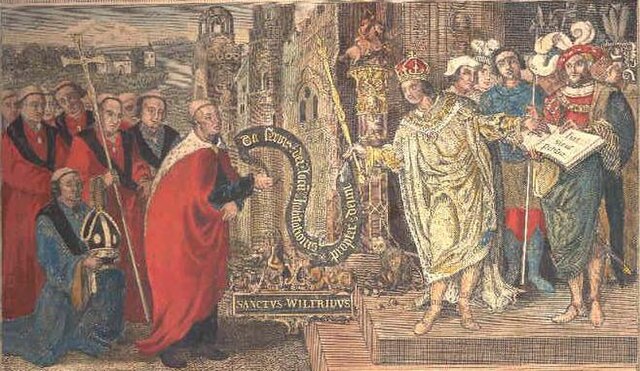Pope Agatho served as the bishop of Rome from 27 June 678 until his death. He heard the appeal of Wilfrid of York, who had been displaced from his see by the division of the archdiocese ordered by Theodore of Canterbury. During Agatho's tenure, the Sixth Ecumenical Council was convened to deal with monothelitism. He is venerated as a saint by both the Catholic and Eastern Orthodox churches. He is said to have been the longest lived Pope ever.
Pope Agatho depicted in the Menologion of Basil II (c. 1000 AD)
Mosaic of Saint Sebastian, added to San Pietro in Vincoli c. AD 680, and therefore contemporaneous with Agatho's reign
Wilfrid was an English bishop and saint. Born a Northumbrian noble, he entered religious life as a teenager and studied at Lindisfarne, at Canterbury, in Francia, and at Rome; he returned to Northumbria in about 660, and became the abbot of a newly founded monastery at Ripon. In 664 Wilfrid acted as spokesman for the Roman position at the Synod of Whitby, and became famous for his speech advocating that the Roman method for calculating the date of Easter should be adopted. His success prompted the king's son, Alhfrith, to appoint him Bishop of Northumbria. Wilfrid chose to be consecrated in Gaul because of the lack of what he considered to be validly consecrated bishops in England at that time. During Wilfrid's absence Alhfrith seems to have led an unsuccessful revolt against his father, Oswiu, leaving a question mark over Wilfrid's appointment as bishop. Before Wilfrid's return Oswiu had appointed Ceadda in his place, resulting in Wilfrid's retirement to Ripon for a few years following his arrival back in Northumbria.

7th-century crypt at Hexham monastery, where Wilfrid may have deposited any relics he brought back from the continent
Later engraving of a picture commissioned in 1519 showing Cædwalla confirming a grant of land, at Selsey, to Wilfrid
Wilfrid (right), with saints Cuthbert (centre) and Aidan (left), depicted in a stained-glass window in the church of St John Lee near Acomb in Northumberland; Hexham Abbey is nearby.





